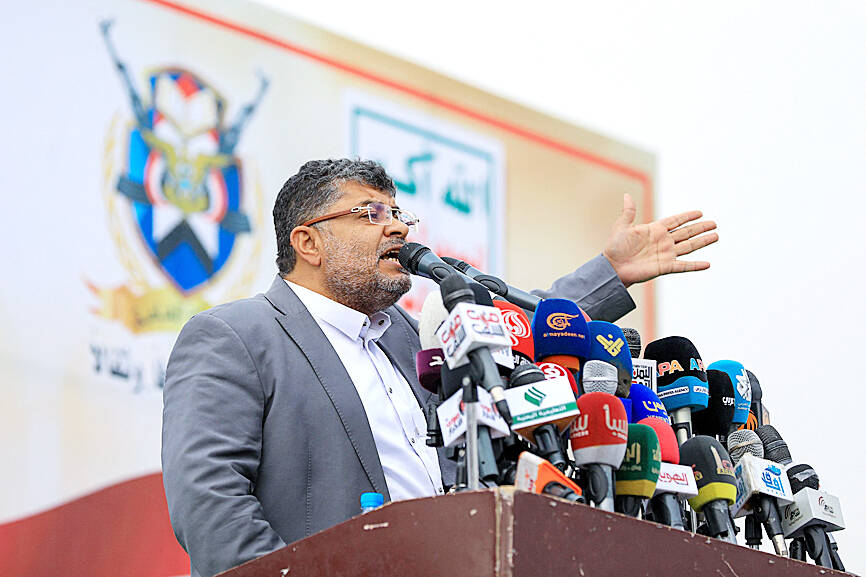The US on Monday confirmed that it would resume sales of offensive weapons to Saudi Arabia, as concerns over human rights in the kingdom’s Yemen war give way to US hopes for it to play a role in resolving the conflict in Gaza.
More than three years after imposing limits on human rights grounds over Saudi Arabian strikes in Yemen, the US Department of State said that it would return to weapons sales “in regular order, with appropriate congressional notification and consultation.”
“Saudi Arabia has remained a close strategic partner of the United States, and we look forward to enhancing that partnership,” US Department of State spokesman Vedant Patel told reporters.

Photo: AFP
US President Joe Biden took office in 2021 pledging a new approach to Saudi Arabia that emphasized human rights and immediately announced that the administration would only send “defensive” weaponry to the longtime US arms customer.
The step came after thousands of civilians — including children — were estimated to have been killed in Saudi Arabian-led airstrikes against Iranian-backed Houthi rebels, who have taken over much of Yemen.
However, geopolitical considerations have changed markedly since then. The UN, with US support, brokered a truce in Yemen in early 2022 that has largely held.
Since the truce, “there has not been a single Saudi airstrike into Yemen and cross-border fire from Yemen into Saudi Arabia has largely stopped,” Patel said. “The Saudis since that time have met their end of the deal, and we are prepared to meet ours.”
It is now the US, the UK and recently Israel that have been striking Houthi targets in Yemen, with Saudi Arabia content to watch from the sidelines.
The Houthis have been firing missiles at commercial ships in the vital Red Sea in professed solidarity with Palestinians, who have been in the crosshairs of Israel since the attack by Hamas on Oct. 7 last year.
In a bid to find a long-term solution, US Secretary of State Antony Blinken has repeatedly traveled to Saudi Arabia to discuss a package of US incentives if the kingdom recognizes Israel.
Saudi Arabia has sought US security guarantees, a continued flow of weapons and potentially a civilian nuclear deal if it normalizes with Israel.
Israeli Prime Minister Benjamin Netanyahu has made normalization with Arab states a top goal and no prize would be as big as Saudi Arabia, guardian of Islam’s two holiest sites, but Saudi Arabia says it cannot act without progress on a Palestinian state, an idea pushed by the Biden administration as it seeks a diplomatic way out of the Gaza conflict, but bitterly opposed by Netanyahu and his far-right allies.
US Representative Joaquin Castro, a progressive member of Biden’s Democratic Party, said that Saudi Arabia still had a “troubling track record” on human rights.
“I supported the Biden administration’s initial decision to pause offensive arms sales to Saudi Arabia, and I hope to see compelling evidence that Saudi Arabia has changed its conduct,” Castro said.
Before Oct. 7 last year, Gulf Arab states had been moving closer to Israel, in large part out of shared hostility to Iran.
Saudi Arabia cooperated with the US, Jordan and the United Arab Emirates, in repelling an Iranian missile and drone barrage against Israel in April.
The US is again hoping for support from Arab partners as Iran threatens another reprisal against Israel over the killing in Tehran of Hamas political leader Ismail Haniyeh.

POLITICAL PRISONERS VS DEPORTEES: Venezuela’s prosecutor’s office slammed the call by El Salvador’s leader, accusing him of crimes against humanity Salvadoran President Nayib Bukele on Sunday proposed carrying out a prisoner swap with Venezuela, suggesting he would exchange Venezuelan deportees from the US his government has kept imprisoned for what he called “political prisoners” in Venezuela. In a post on X, directed at Venezuelan President Nicolas Maduro, Bukele listed off a number of family members of high-level opposition figures in Venezuela, journalists and activists detained during the South American government’s electoral crackdown last year. “The only reason they are imprisoned is for having opposed you and your electoral fraud,” he wrote to Maduro. “However, I want to propose a humanitarian agreement that

ECONOMIC WORRIES: The ruling PAP faces voters amid concerns that the city-state faces the possibility of a recession and job losses amid Washington’s tariffs Singapore yesterday finalized contestants for its general election on Saturday next week, with the ruling People’s Action Party (PAP) fielding 32 new candidates in the biggest refresh of the party that has ruled the city-state since independence in 1965. The move follows a pledge by Singaporean Prime Minister Lawrence Wong (黃循財), who took office last year and assumed the PAP leadership, to “bring in new blood, new ideas and new energy” to steer the country of 6 million people. His latest shake-up beats that of predecessors Lee Hsien Loong (李顯龍) and Goh Chok Tong (吳作棟), who replaced 24 and 11 politicians respectively

Young women standing idly around a park in Tokyo’s west suggest that a giant statue of Godzilla is not the only attraction for a record number of foreign tourists. Their faces lit by the cold glow of their phones, the women lining Okubo Park are evidence that sex tourism has developed as a dark flipside to the bustling Kabukicho nightlife district. Increasing numbers of foreign men are flocking to the area after seeing videos on social media. One of the women said that the area near Kabukicho, where Godzilla rumbles and belches smoke atop a cinema, has become a “real

‘WATER WARFARE’: A Pakistani official called India’s suspension of a 65-year-old treaty on the sharing of waters from the Indus River ‘a cowardly, illegal move’ Pakistan yesterday canceled visas for Indian nationals, closed its airspace for all Indian-owned or operated airlines, and suspended all trade with India, including to and from any third country. The retaliatory measures follow India’s decision to suspend visas for Pakistani nationals in the aftermath of a deadly attack by shooters in Kashmir that killed 26 people, mostly tourists. The rare attack on civilians shocked and outraged India and prompted calls for action against their country’s archenemy, Pakistan. New Delhi did not publicly produce evidence connecting the attack to its neighbor, but said it had “cross-border” links to Pakistan. Pakistan denied any connection to